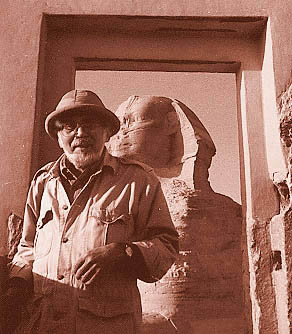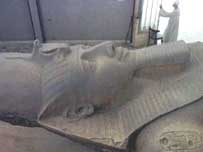Archive for the ‘Ancient Egypt’ Category
Independent Egyptologist John Anthony West Discusses Ancient Egypt on Red Ice Radio

One of the most fascinating and brilliant researchers and alternative historians, on the ancient Egyptian world, simply must be John Anthony West. His work has truly revitalized many people’s understanding of ancient Egypt, a subject which is often clouded by the uninspired and often dim witted theories of the modern-day quackademics in the field of Egyptology.
West is well known for his work with actor Charleton Heston and geologist Robert Schoch on Mystery of the Sphinx; a documentary which details his theory that, due to evidence of water erosion on the Sphinx, this monument must be thousands of years older than is currently believed by the academic Egyptologists. He also made a fantastic documentary called Magical Egypt, which is a Symbolist view of the ancient Egyptian world.
This alternative perspective, espoused by J.A. West, operates under the premise that the ancient Egyptians can do a far better job of telling their own history, in their own words, than the contemporary researchers. These academics largely ignore the Egyptian writings as fanciful myths and fail to grasp the true meaning of many of the temples and artifacts they study. Read the rest of this entry »
Symbolist Egypt – the Meaning Behind the Magic
This video features John Anthony West speaking at a conference; it only recently became available on the web. The video was excerpted from a conference called Return to the Source : Rediscovering Lost Knowledge and Ancient Wisdom.
In the lecture, he explains his theories on ancient Egypt, detailing the manner by which his truly independent perspective was developed: his influences, experiences and how his understanding of symbolist Egypt evolved over the many years of his career.
Architecture does in stone what music does in sound; in other words, its visual vibrations that are affecting us. We’re inside the symphony, as it were, when we’re inside a sacred space. We’re being affected emotionally by the vibrational nature of that particular building.
So when we go into an Egyptian temple, we are resonating to its harmonies and proportions and so-on. The great sages of the past understood that each of the cosmic principles, which are the gods as it were. The gods are not some strange animal headed beings, they are the embodiments of cosmic principles and those cosmic principles are inextricably related to certain interplay of numbers which give rise to geometry, harmony, proportion and measure.
When you know the secrets of the numbers and secrets of the principles, you are able to produce a building that will evoke within the emotional center of the beholder, that particular principle.
–John Anthony West
Symbolist Ancient Egypt
The artifacts and monuments of ancient Egypt have a significance that goes far beyond the “funerary” meaning that is conventionally applied to them. Many great temples, such as the Temple of Luxor, actually represent the growth of man in four dimensions; they also represent the growth of the Universe through time. One of the most interesting aspects of the Luxor temple, is how it shows the mathematical relation between Human and Universe.
When you look deeply into the story in the words of the ancient Egyptians; and you take them at their word, instead of the word of an outside “academic” observer, you see a completely different perspective of these people and their culture.
The symbolist interpretation of ancient Egyptian history is a rich and vast web of intricacy, which creates a true understanding of what this culture was trying to accomplish.
Their goal was not to preserve their physical bodies for all of time; instead it was to become attuned to the divinity within themselves, by living a life in touch with divine principles. Then they will have significantly enhanced their awareness, so they can move towards higher forms of being in the after-life.
The following is a selection from Magical Egypt, a documentary by John Anthony West, in which he unravels the mysteries of ancient Egypt and the Mystery Schools, from a symbolist perspective.
The Dogon and the Sirius Mystery
George Noory interviews Robert Temple about his book The Sirius Mystery and the Dogon tribe of Mali.
According to anthropological studies, the Dogon Tribe of Africa developed a religion based on the Sirius star system and were aware of Sirius B (a companion star that can’t be seen with the naked eye) as well as a third star in that system which wasn’t confirmed by astronomers until 1995, nearly 20 years after Temple wrote about it in his book.
The Dogons believed that beings from a planet in the Sirius system came to Earth in the distant past, landing in a place where their ancestors came from (Temple suggested that this was probably Egypt). These ETs were slimy, air-breathing aquatic creatures that had fish-like tails and arms without elbows, and he noted that similar beings have also been described in ancient China, Greece, and Sumeria. The Dogons said that when the ETs were here, a new star appeared in the sky that disappeared after they left. Temple surmised that this was likely their orbiting mother ship.
Independant Egyptologist, John Anthony West at CPAK 2007
John Anthony West helped popularize the evidence for water weathering on the Great Sphinx of Giza. Based on the evidence he and several geologists have analyzed, J.A. West theorizes that the Sphinx is probably at least 30,000 years old.
Mr. West is preparing to assemble a panel of geologists together, so they can further analyze the weathering on the Sphinx; hopefully opening the way for academia to acknowledge that they were incorrect about the dating of ancient Egypt.
Edgar Cayce on the Great Pyramid and Sphinx
The psychic reading, given in 1932, on the Sphinx and Great Pyramid at Gizeh, is one of the most fascinating readings about the origins of the ancient world. There are many perplexing mysteries concerning the construction and purpose of the monuments of ancient Egypt and South America.
Atlantean origin of these peoples seems to explain the sudden appearance of great monuments and high culture in both Egypt and South America. It seems highly unlikely that the people there, who had been living in mud brick huts, could advance to a higher level of mathematical, architectural and esoteric understanding than our own culture with no antecedent steps of development. Read the rest of this entry »
Kahotep and the rise of Egypt
The color purple has, for centuries, often been associated with power, royalty, wealth, and strength. Engineers have a time-tested tradition of soaking themselves with purple dye. This is done to commemorate the honorable engineer Kahotep.
An ancient Egyptian story tells that Kahotep was an Egyptian scholar who is estimated to have lived around 3500 B.C. By today’s standards, he would have been considered to be a mineral engineer, as he built wells in many town not directly along the Nile. Read the rest of this entry »
Massive Sun Temple discovered: the largest ever found in Egypt
 The confidence of these archaeologists never ceases to amaze me. I have many doubts about the date ranges that these guys give for the sites that they uncover in Egypt. I sometimes wonder whether or not they make up the dates simply to fit their beliefs.
The confidence of these archaeologists never ceases to amaze me. I have many doubts about the date ranges that these guys give for the sites that they uncover in Egypt. I sometimes wonder whether or not they make up the dates simply to fit their beliefs.
My research indicates that the generally accepted date of the Great Pyramid and Sphinx are off by about 5000 years; they should really be around 10,000 B.C.E.
Associated Press
February 28, 2006CAIRO: A popular outdoor market in the east of Egypt’s capital city will be shut down after archaeologists discovered a pharaonic sun temple with large statues believed to be of King Ramses II beneath it. Read the rest of this entry »
